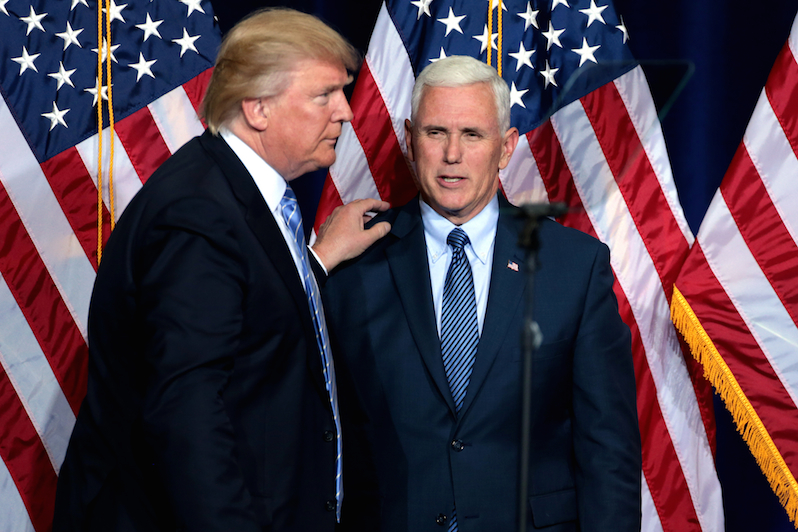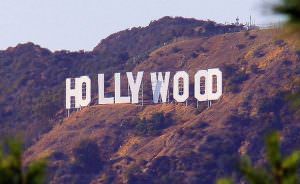Private Money Goes After Trump’s Public Infrastructure Projects
The current lobbying push has links to a former disaster involving Mike Pence. Plus, Scott Pruitt’s industry connections run deep, and Trump Org had big plans for Soviet states. President Trump and Vice President Mike Pence. (Gage Skidmore / CC 2.0)
President Trump and Vice President Mike Pence. (Gage Skidmore / CC 2.0)
By Matt Smith and Lance Williams, Reveal
President Trump and Vice President Mike Pence. (Gage Skidmore / CC 2.0)
A group of Australian pension fund managers met recently with Trump infrastructure czar Richard LeFrak, part of a lobbying push to open the administration’s plans to Australian investment.
That lobbying effort will continue next month as Mike Baird, ex-premier of the Australian state New South Wales is joined by an executive with the Australian investment firm IFM, to to boast about Australia’s record privatizing facilities such as ports and roads.
“As they bring forward their trillion-dollar infrastructure plan to Congress, the Americans are going to need to flesh out how they are going to implement it and it wouldn’t surprise me to see us as part of that implementation program,” an Australian Financial Review story quoted an Australian pension fund official as saying.
It turns out some of the same Australians seeking new U.S. infrastructure deals have already had their hands in a privatization project that was once a bane of former Indiana governor and current Vice President Mike Pence.
In 2015, IFM bought into a privatized U.S. roadway that has been such a functional and financial disaster that it’s been dubbed privatization’s “highway to hell.”
A Spanish firm was supposed to build and manage an Indiana roadway extension. But the project ran years behind schedule, and the delays increased collisions, lengthened commute times, and cost the state millions of overrun dollars. IFM scooped the project out of bankruptcy in 2015.
The bankruptcy affected approximately 5,000 businesses and agencies that had done business with the Spanish firm, according to federal court records obtained by Reveal.
Two weeks ago the Indiana essentially admitted the project was a complete failure by announcing the state government would take over the project. Two days later Indianapolis Star investigative reporters Mark Alesia and Kaitlin Lange published “Mike Pence’s Infrastructure Mess.” The reporters said state officials missed red flags surrounding the Spanish company, Isolux Corsan.
Early in his administration President Donald Trump announced what was to be a trillion-dollar U.S. infrastructure rebuild, offering vague indications they would be financed largely with private capital rather than taxpayer funds.
He appointed an infrastructure council, led by New York energy and real-estate tycoon LeFrak, who had previously obliged Trump as a Miss Universe judge, a “The Apprentice” guest, and a frequenter of Mar-A-Lago. The council also includes long-time Trump business partner Steven Roth.
LeFrak said at an April investment seminar said that “political courage is needed right now” to raise either tolls, taxes or both to pay for infrastructure. Roth, for his part, said the key was private capital and “an enormous amount of leverage and debt.”
Though controversial, private infrastructure doesn’t have to fail, with roads in Israel and Australia touted as success stories. But infrastructure privatization schemes are vulnerable to political corruption.
That’s because by definition they involve politicians transferring billions of dollars worth of assets to private hands. Former California Gov. Arnold Schwarzenegger was poised to sell the state’s most prized government buildings to secretive companies set up by his cronies – until he was outed in the press. The oligarch fortunes of the former Soviet Union tend to be ascribed to corrupt asset privatization schemes.
Even without overt corruption, privatization policies are vulnerable to cronyism and revolving doors.
Which brings us back to Baird, the Australian privatization guru. He resigned in January reportedly to spend more time with his family, after gaining fame, and detractors, for inking multi-billion dollar privatization deals for Australian port and electricity facilities. Press reports said his government was down in the polls just as opponents claimed privatizations failed to produce economic results.
A month after Baird stepped down he joined National Australia Bank, which has pledged $100 billion in Australian infrastructure financing during the next seven years. Next month Baird will be in the U.S. along with an IFM executive touting Australian deals where the sale of government assets would be used to finance future infrastructure.
Scott Pruitt’s Energy Connections Run Deep
Last week, a top science advisor at the Environmental Protection Agency contended the agency had “bullied” her in an effort to get her to alter Congressional testimony about the administration’s attempts to make the EPA more industry-friendly.
At issue, said environmental chemist Deborah Swackhamer, was the administration’s decision to dismiss half of the 18 executive members of the EPA’s science advisory panel, which was set up to ensure that the EPA follows scientific best practices.
President Trump once tweeted that global warming is a hoax created by the Chinese. His EPA administrator, Scott Pruitt, forged strong connections to the energy industry when he became — in his own words — a “leading advocate against the EPA’s activist agenda” as attorney general of Oklahoma.
The dismissed scientists might be replaced with representatives of industries regulated by the EPA, an agency spokesman said.
Swackhamer, a retired University of Minnesota professor and leader of the panel, prepared written testimony before appearing before the House Science Committee May 23.
She noted the dismissals, commenting that they could “lead to the perception that science is being politicized and marginalized within EPA.” Appointees to the science panel “must be esteemed scientists with no conflict of interest,” she also wrote.
But the day before the hearing, Swackhamer said she received emails from Ryan Jackson, Pruitt’s chief of staff, claiming that “a decision has not been made” about whether to replace the scientists, even though some had already received letters saying they had been dismissed. Jackson sent her administration talking points and urged her to use them to rework her testimony.
“I was stunned that he was pushing me to ‘correct’ something in my testimony,” she told The New York Times. “I was factual, and he was not. I felt bullied.”
Democrats on the committee accused Jackson of attempting to interfere with the scientist’s testimony. Chairman Lamar Smith, Republican of Texas, said the EPA was merely trying to ensure that the scientist’s testimony was accurate. He accused Democrats of trying to politicize the matter.
This underscored Pruitt’s ties to the industries the EPA regulates.
As attorney general of Oklahoma, Pruitt repeatedly sued the EPA to blunt its regulation of the energy industry, which gave him political contributions.
Pruitt maintained two federal political action committees, suggesting he planned to run for federal office at some point.
From 2014 to 2016, his Liberty 2.0 PAC raised $450,000. Its biggest donation was $50,000 from Murray Energy, the nation’s biggest coal mining concern, records show. The company’s combative CEO, Robert Murray, has derided efforts to curb global warming as an “economic suicide note” for the nation’s coal miners.
Other big donors were JMA Energy ($25,000), an Oklahoma natural gas concern and Continental Resources ($15,000), an Oklahoma oil company that says it is the largest leaseholder in the Bakken oil field in North Dakota.
Pruitt’s Oklahoma Strong PAC raised about $400,000, with hefty donations from employees of Alliance Resources, the second biggest U.S. coal company ($15,000), and Warren Oil, Medallion Petroleum and Devon Energy, all Oklahoma energy companies ($5,000 apiece.)
Both PACS were run by Pruitt’s political consultant, Millan Hupp. She now works for the EPA.
Trump had big plans for former Soviet territory
Kevin Hall of McClatchy’s Pulitzer Prize winning Panama Papers team has released a new deep dive, this time into Donald Trump’s extensive venturing into former Soviet territory, where he had hoped to build a business empire.
Trump sought to have his name atop a glass tower in the capital of Kazakhstan, wanted a trademark in Iran for possible hotels, and until a deal was nixed this January, Trump was poised to build a 47-story Trump tower in the former Soviet republic of Georgia. The company would have presented conflicts for a sitting president, the story said.
His erstwhile partner, Silk Road Group, “had oil trading and transport deals with companies in both Russia and Iran, countries currently facing varying degrees of U.S. and European financial sanctions.”
Matt Smith can be reached at [email protected], and Lance Williams can be reached at [email protected]. Follow them on Twitter: @SFMattSmith and @LanceWCIR.
![]()
This story was originally published by Reveal from The Center for Investigative Reporting, a nonprofit news organization based in the San Francisco Bay Area. Learn more at revealnews.org and subscribe to the Reveal podcast, produced with PRX, at revealnews.org/podcast.
Your support matters…Independent journalism is under threat and overshadowed by heavily funded mainstream media.
You can help level the playing field. Become a member.
Your tax-deductible contribution keeps us digging beneath the headlines to give you thought-provoking, investigative reporting and analysis that unearths what's really happening- without compromise.
Give today to support our courageous, independent journalists.





You need to be a supporter to comment.
There are currently no responses to this article.
Be the first to respond.